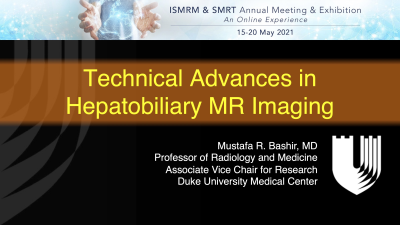Weekday Course
The Hows & Whys of Pancreatic & Hepatobiliary Imaging: An Update
ISMRM & ISMRT Annual Meeting & Exhibition • 03-08 June 2023 • Toronto, ON, Canada

| 08:00 |
High-Risk Pancreas Clinic: What’s Behind the Imaging?
Paul James
|
|
| 08:25 |
Imaging the At-Risk Pancreas
Ihab Kamel
Keywords: Body: Digestive - Discuss the rationale behind pancreatic cancer screening/surveillance in at risk patients. - Summarize what we know to date regarding the role of clinical imaging at baseline and subsequent follow ups. - Emphasize the value of novel high-resolution imaging techniques and careful image interpretation in early detection of pancreatic cancer. - Identify challenges and gaps in knowledge related to pancreatic cancer screening/surveillance. - List promising future approaches including precision medicine using artificial intelligence to incorporate family history, genetics, environment, clinical imaging, and biomarkers. |
|
| 08:50 |
 |
Technical Advances in Hepatobiliary MR Imaging
Mustafa Bashir
Keywords: Body: Liver This talk will describe technological solutions to enable high-quality hepatobiliary MRI. |
| 09:15 |
Role of Hepatic MR in the Management of Oligometastatic Disease Video not available SS Baijal |
|
| 09:40 |
Break & Meet the Teachers |
|
| 10:05 |
NASH: Clinical Relevance & Perspective
Keyur Patel
Keywords: Cross-organ: Metabolic disease, Body: Liver The global prevalence of non-alcoholic fatty liver disease (NAFLD) is estimated at 25%. Non-alcoholic steatohepatitis (NASH) affects ~20% of NAFLD patients leading to progressive liver fibrosis and cirrhosis. The incidence of liver decompensation, liver cancer, and death related to NASH cirrhosis is expected to increase 2-3 fold over the next decade. Liver biopsy is the reference for diagnosing NASH and fibrosis, but non-invasive serum tests and imaging tools are increasingly available for the diagnosis of advanced fibrosis. Current medical management for NASH includes lifestyle intervention and treatment of metabolic disease, but there are currently no FDA-approved compounds for NASH. |
|
| 10:30 |
 |
Update on Quantitative Biomarkers for Liver Fibrosis
Shintaro Ichikawa
Keywords: Body: Liver, Contrast mechanisms: Diffusion, Contrast mechanisms: Elastography Cirrhosis is the most important risk factor for hepatocellular carcinoma; therefore, it is important to accurately assess advanced fibrosis. Liver biopsy remains the gold standard for diagnostic evaluation of hepatic fibrosis. However, its invasive nature and high cost make it difficult to perform repeatedly. MRI is a noninvasive imaging tool that can evaluate hepatic fibrosis. There are several methods to assess hepatic fibrosis on MRI. This talk will provide an overview of diagnostic methods for hepatic fibrosis by MRI including uptake of gadoxetic acid, T1 mapping, diffusion-weighted imaging including intravoxel incoherent motion, T1rho, radiomics/ artificial intelligence, and MR elastography. |
| 10:55 |
Liver Fat & Iron Quantification: How I Do It
Manuela Franca
Keywords: Body: Liver, Image acquisition: Quantification MRI has been established as a powerful imaging tool to evaluate diffuse liver diseases. Liver MRI offers a comprehensive assessment of the different tissue components, providing quantitative imaging biomarkers for fat and iron quantification. Multi-echo chemical-shift encoded (MECSE) gradient echo MR sequences are now widely used for simultaneous quantification of hepatic steatosis and siderosis.In this session, the use of MECSE sequences for liver fat & iron quantification will be explained, in different clinical scenarios of diffuse liver diseases, giving some tips and tricks for the technical implementation, analysis, interpretation and clinical use of liver fat and iron MR quantification. |
|
| 11:20 |
Abbreviated MRI for HCC Screening: Extracellular vs.
Hepatobiliary Agents
Bachir Taouli
Keywords: Body: Liver In this presentation, we will discuss current guidelines for HCC screening/surveillance, and limitations of US screening, and the opportunities based on abbreviated MRI for this indication. Advantages and limitations of extracellular vs hepatobiliary gadolinium based contrast agents will be discussed. |
The International Society for Magnetic Resonance in Medicine is accredited by the Accreditation Council for Continuing Medical Education to provide continuing medical education for physicians.